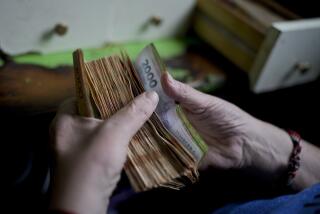The Highest and Lowest Common Denominations
- Share via
A $100 bill has Benjamin Franklin’s face on it. That new blown-up photo of Ben on the C-note doesn’t do him any favors. His jowls droop and he’s having a bad hair day. He could use a make-over.
Fred Weinberg is a guy who knows a lot about American money. He is someone who can quickly answer a trivia question.
“Whose face is on a $500 bill?”
“Funny you ask,” Weinberg says. “Because I just looked that up, in case I ever get to go on TV on ‘Who Wants to Be a Millionaire?’ ”
William McKinley, 25th president of the United States, is on the $500 bill, he says.
“So who’s on the $1,000?”
That would be Grover Cleveland, the 22nd and 24th president, Weinberg says.
Whereupon he asks: “You do know that there’s also a $5,000 bill and a $10,000, don’t you?”
James Madison, our fourth president, adorns a 5-grand note, Weinberg says.
And on a $10,000 bill. . . ?
Oh, of course. We should have known.
“Salmon Chase.”
*
This roundabout conversation began after a ceremony held last Thursday to mark the first minting of the “Golden Dollar,” a $1 U.S. coin that will go into circulation early next year.
Weinberg, who is from Encino, is president of the Professional Numismatists Guild, a nonprofit organization of currency experts.
He is quite interested in this new $1 golden-hued coin, which is made of copper, nickel, zinc and manganese. It features Sacajawea, a young Shoshone Indian woman who guided explorers Lewis and Clark on their 1805 expedition.
“The big question is, will the new coin be regularly used as pocket change?” Weinberg wonders.
But first, there is another question about Sacajawea:
Did she get a face lift?
Weinberg believes she might have. He says, “If you compare the actual coin to the artist’s original drawing last year, it’s obvious that the Treasury Department has given Sacajawea’s face an Ally McBeal nose job and glamorized her cheeks.”
Ally McBeal, the fictional TV lawyer?
“I mean they gave Sacajawea a cuter, perkier little nose, like that actress [Calista Flockhart] has,” Weinberg says.
If true, we see no reason why Benjamin Franklin shouldn’t also be given a few nips and tucks.
Temperance and suffrage activist Susan Brownell Anthony’s profile appeared on a $1 coin in the 1970s. Nobody messed with Anthony’s face; feminists would have been furious.
Unfortunately, the Susans never caught on. They became the Edsels of coins. Even though they were octagonal, the $1 coins were silver and too similar to 25-cent pieces in their size and weight.
The government’s new Golden Dollar is heavier and won’t be accidentally dropped as often into a Coke machine.
If Americans are going to use the Sacajawea dollar, though, the paper $1 bill might have to be put to sleep.
“We don’t advocate the elimination of any current denomination,” Weinberg says, “but frankly, the Treasury Department may have to look at stopping production of $1 bills to make the new $1 coin successful. The United States used to have a half-cent, 2-cent and 3-cent coin and even a 20-cent denomination in circulation. Perhaps the day will come when $1 bills will be obsolete.
“Canada, Australia and England learned from the mistakes of the Susan B. Anthony dollar. Those countries simultaneously eliminated production of 1-dollar and 1-pound paper money when they introduced coins of the same denomination.”
It isn’t as if America would be abandoning George Washington. His face is already on a quarter.
Besides, the mint could create a new $35 or $75 bill with Washington’s kisser on it . . . Salmon Chase being taken.
*
OK, OK, here’s your $10,000 question:
Salmon P. Chase’s picture appears on a $10,000 bill. Was he:
(a) The man who invented money? (b) That guy who wrote “The Satanic Verses?” (c) The original guide who got Lewis and Clark lost in the first place? (d) Abe Lincoln’s secretary of the Treasury?
The correct answer is (d). Chase was also a U.S. senator, governor of Ohio and chief justice of the United States, so shame on you if you didn’t know.
A $500 bill--no longer printed--is so rare that one is worth from $600 to $650, Weinberg says. “And a $1,000 bill is worth 12 to 15 [thousand]. So you can imagine what a $10,000 bill could bring.”
Particularly if one was made giving Salmon a nose job.
Mike Downey’s column appears Sundays, Wednesdays and Fridays. Write to him at Times Mirror Square, Los Angeles 90053. E-mail: mike.downey@latimes.com
More to Read
Inside the business of entertainment
The Wide Shot brings you news, analysis and insights on everything from streaming wars to production — and what it all means for the future.
You may occasionally receive promotional content from the Los Angeles Times.










